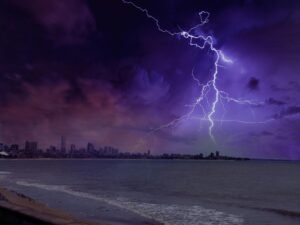Contents
ToggleLightning and Surge Protection
Lightning strikes, often dismissed as a fleeting spectacle, pose a serious threat to buildings. These powerful discharges can unleash immense energy, causing electrical surges that can damage equipment, disrupt operations, and even ignite fires.
The Vulnerability of Unprotected Structures
Buildings lacking adequate lightning protection systems are particularly vulnerable. A direct strike can wreak havoc on electrical systems, leading to short circuits, equipment failures, and costly repairs. Beyond the immediate damage, these incidents can result in significant downtime, data loss, and pose serious safety risks to occupants. The unpredictable nature of lightning makes this threat even more concerning – a single storm could have devastating consequences.
A Shield Against Electrical Disasters: Lightning and Surge Protection Systems
Fortunately, effective protection measures are available. By implementing a comprehensive lightning protection system (LPS) and integrating surge protection devices (SPDs), building owners can significantly mitigate the risks associated with lightning strikes and electrical surges.
Key Components of a Robust Lightning Protection System:
- Air Terminals: Strategically placed on the highest points of the building, these act as the first line of defense, intercepting lightning strikes and providing a safe path for the current to flow.
- Down Conductors: These conductive pathways, typically made of copper or aluminum, guide the lightning current safely to the ground.
- Grounding System: A network of buried electrodes ensures that the lightning current is safely dissipated into the earth, minimizing the risk of damage to the building structure.
Surge Protection: Safeguarding Your Electrical Investments
Electrical surges can originate from various sources, including lightning strikes, power grid faults, and switching operations. These sudden surges of voltage can severely damage sensitive electronic equipment, leading to costly repairs or even data loss.
Surge protection devices (SPDs) are strategically installed within the building’s electrical system to mitigate the impact of these surges. These devices are designed to absorb or divert excess voltage and current, safeguarding valuable equipment from damage.
Design, Installation, and Maintenance for Optimal Protection
The design and installation of LPS and SPDs require careful consideration. Factors such as building height, location, and exposure to lightning strikes must be carefully assessed to ensure optimal protection. Adherence to industry standards, such as IEC 62305, is crucial for effective system performance.
Regular maintenance and inspections are essential to maintain the integrity and effectiveness of the protection systems. This includes periodic checks of grounding connections, air terminals, and the functionality of SPDs.
Prioritize Protection: An Investment in Safety and Resilience
Investing in a robust lightning and surge protection system is not merely a precautionary measure; it’s a strategic decision that prioritizes safety, minimizes operational disruptions, and protects valuable assets. By implementing these measures, building owners can enhance the resilience of their structures and safeguard against the unpredictable forces of nature.









